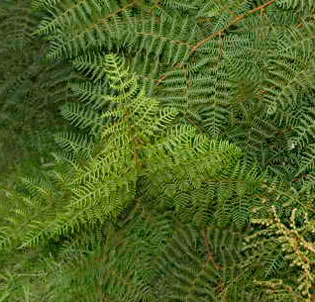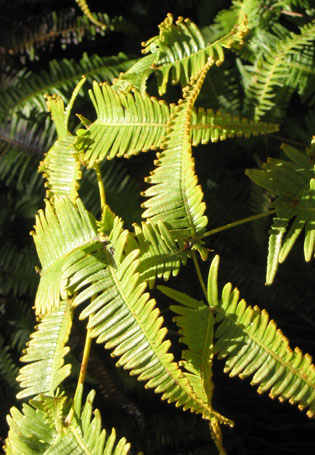Note. This is one of the pages written and later revised in the prototype stage of this web site, which has been transferred with minimal changes to the newer format.
 When this page was first written (2009) the Pollex database gives Dicranopteris linearis as the probable gloss for the Proto-Polynesian word from which the contemporary words for this group of ferns are derived. In 2024, however, it is simply glossed as "a fern". However, looking at the plants the modern Tongan reflex designates, none of which are a Dicranopteris or closely allied species, and also the cognates in other languages, it seems to me that originally *hulufe (or perhaps *sulufe -- the form the original consonant took is hard to determine) was a generic term for certain kinds of somewhat invasive ferns with stolons that enabled them to spread over wide areas. In some parts of Eastern Polynesia Dicranopteris linearis would have been the "hulufe" par excellence, whereas in Aotearoa this was (and remains) Pteridium esculentum (shown on the left), and in the Marquesas it became a Diplazium and Chingia species. Many of them form tangled masses, which makes it easy to see why the name was given to the Hawaiian and New Zealand species. Going off on a slight tangent, it may have been their nest-like shape that led to the association (noted below) between Nephrolepis biserrata and Asplenium nidus in Tongan. The Pollex database currently (2024) gives the following gloss for the Tongan refex of the Proto-Polynesian word "General name for ferns, most commonly applied to Nephrolepis hirsutula, indigenous sword fern"; the entry in the Tongan version of Wikipedia is more specific, and puts the native (albeit cosmopolitan) Nephrolepis biserrata in first place; it gives qualified status, as hulufe lauʻitelinga, to N. hirsutula, a Southeast Asian/Pacific species, but not native to Tonga according to the Kew database. When this page was first written (2009) the Pollex database gives Dicranopteris linearis as the probable gloss for the Proto-Polynesian word from which the contemporary words for this group of ferns are derived. In 2024, however, it is simply glossed as "a fern". However, looking at the plants the modern Tongan reflex designates, none of which are a Dicranopteris or closely allied species, and also the cognates in other languages, it seems to me that originally *hulufe (or perhaps *sulufe -- the form the original consonant took is hard to determine) was a generic term for certain kinds of somewhat invasive ferns with stolons that enabled them to spread over wide areas. In some parts of Eastern Polynesia Dicranopteris linearis would have been the "hulufe" par excellence, whereas in Aotearoa this was (and remains) Pteridium esculentum (shown on the left), and in the Marquesas it became a Diplazium and Chingia species. Many of them form tangled masses, which makes it easy to see why the name was given to the Hawaiian and New Zealand species. Going off on a slight tangent, it may have been their nest-like shape that led to the association (noted below) between Nephrolepis biserrata and Asplenium nidus in Tongan. The Pollex database currently (2024) gives the following gloss for the Tongan refex of the Proto-Polynesian word "General name for ferns, most commonly applied to Nephrolepis hirsutula, indigenous sword fern"; the entry in the Tongan version of Wikipedia is more specific, and puts the native (albeit cosmopolitan) Nephrolepis biserrata in first place; it gives qualified status, as hulufe lauʻitelinga, to N. hirsutula, a Southeast Asian/Pacific species, but not native to Tonga according to the Kew database.
 Although most of these ferns have no trouble holding their own, a few have become quite elusive. In 2010 my friend the late Greg Trifanovich on the Big Island of Hawaii generously offered to help me hunt for Diplopterygium pinnatum, supposedly common in wet forests and hillsides, and Sticherus owhyensis, another member of the Gleicheniaceae sharing the name uluhe. We searched many likely sites, but all we could find was the ubiquitous Dichanopteris (portrayed on the right). I also looked for those two species on Oahu and Kaua'i, with similar results! There were many false sightings, all of which on investigation turned out to be more Dichanopteris swarms. I have been told they would be easier to find on the island of Maui, but unfortunately I was researching early contacts between whalers and local populations rather than plants bearing inherited names when I was last there in 2005. Although most of these ferns have no trouble holding their own, a few have become quite elusive. In 2010 my friend the late Greg Trifanovich on the Big Island of Hawaii generously offered to help me hunt for Diplopterygium pinnatum, supposedly common in wet forests and hillsides, and Sticherus owhyensis, another member of the Gleicheniaceae sharing the name uluhe. We searched many likely sites, but all we could find was the ubiquitous Dichanopteris (portrayed on the right). I also looked for those two species on Oahu and Kaua'i, with similar results! There were many false sightings, all of which on investigation turned out to be more Dichanopteris swarms. I have been told they would be easier to find on the island of Maui, but unfortunately I was researching early contacts between whalers and local populations rather than plants bearing inherited names when I was last there in 2005.
Several of the ferns listed here have undergone scientific name changes over the last few decades. Diaplazium harpoedes is not recognized in the Kew database (although that name has been in use since 1861, and is the name used in the recently published (2019) Flora of the Marquesas Islands); the related Tahitian fern D. polyanthes is listed there; Chingia longissima was formerly Cyclosorus longissimus, Dryopteris nukuhivensis, then D. longissimus var. nukuhivensis; and Diplopterygium pinnatum was once Hicriopteris pinnata or H. glabra. The genus Diplazium appears to have been shifted by some taxonomists, along with others in the family-formerly-known-as Athyriaceae, to the family Woodsiaceae, and by others to the family Dryopteridiaceae; in the Kew database this genus is placed in the Aspleniaceae. The USDA Germ Plasm Resources Information Network (GRIN) Database notes these changes but continues to list the genera concerned under a variety of other family names, with Woodsia (the "type" genus) and Athyria (the "type" genus of the Athyriaceae) placed along with Diplazium in the Dryopteridiaceae. For the moment I have kicked for touch and, following the authors of the Flora of the Marquesas Islands, left Diplazium listed as being in the Athyriaceae. Furthermore, in the POLLEX database the Proto Polynesian term was earlier reconstructed as *halufe, which was originally the one used on this page; it has since been amended to *salufe ~ *(h,s)(a,u)(l,n)ufe. Dr Paul Geraghty has also studied the reflexes of the original word, and we have accepted his suggestion of *hulufe, *sulufe, with the change of the first vowel from "u" to "a" later, as more plausible. Alternations between l/r and n are not uncommon within and between Polynesian languages in certain words. The Pollex database has separate but cross-referenced entries for *salufe as Proto-Polynesian ancestral word, covering the Western Polynesian as well as the Marquesan and Hawaiian forms, and *Aruhe as a Proto-Tahitic form. This division seems somewhat artificial to me, but should be noted nonetheless.
And just to complicate matters further, the Tongan-language version of Wikipedia adds several more species of fern to those listed in the table of reflexes above under the names hulufe or holufe. These are: hulufe leisi -- Arachnoides aristata (Aspidiaceae), and Loxoscalphe gibberosum (Aspleniaceae); hulufe ta'elau'itelinga -- Nephrolepis hirsutula (Nephrolepidaceae) ; and hulufe vai -- Angiopteris evecta (Marattiaceae), also, probably more commonly, known as ponga. This latter fern is known as palatao (another heritage name) in Niue.
The aruhe (the root of Pteridium esculentum), despite its blandness and carcinogenic qualities, became critically important as a staple in Aotearoa. A silver-leaved cultivated variety of Pteris ensiformis (Tongan hulufe uhi) is widely grown as a garden plant; it has naturalized itself in the Cook Islands and is noted and illustrated in the Cook Islands biodiversity database.
Gallery
|

